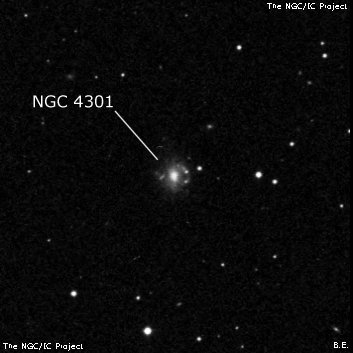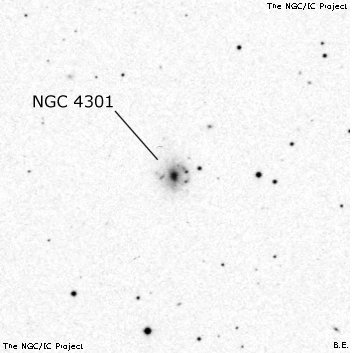NGC/IC Project Restoration Effort
(This is a very very beta version)
NGC4301


Basic Information
Location and Magnitude
Right Ascension: 12:22:27.2
Declination: +4:33:57
Constellation: VIR
Visual Magnitude: 13.0
Historic Information
Discoverer: Stoney B.
Year of discovery: 1851
Discovery aperture: 72.0
Observational
Summary description: F, E, 10' nf h 1196
Sub-type: SBc
Corwin's Notes
=====
NGC 4301 is one of the "classic" cases of a problem NGC object. People have
been puzzling over it since Bindon Stoney found it on 1 March 1851 with LdR's
Parsonstown Leviathan. Sue French just (May 2006) asked about it, so I am
finally digging into the records to find out what I can about it. I must
mention, too, that Malcolm Thomson has made valuable contributions to solving
this puzzle. More on that as we go along. (There is a bit more in the
"notngc" files under NGC 4292A.)
Here is the story:
In his 1861 paper, LdR has NGC 4292 and NGC 4303 listed together as having
been observed five times. He continues,
Sketched 4 times. March 1, 1851. [h]1196 [= N4292] is bM and has a vF
comp.; [h]1202 [= N4303 = M 61] is a spiral, B. centre, and 2 knots. There
is another neb. 10' nf.
Here's the first bit of confusion. Is the nebula 10 arcmin northeast of N4292
or N4303? LdR's note can be read either way. I'll lay out some arguments
below suggesting that it is northeast of N4303 and not N4292 as many,
including Dreyer himself, have supposed.
A second bit of confusion follows immediately, still apparently in the same
observation of N4292 and N4303:
About 84[deg] 34' N.P.D., and 12h 25m AR. There is a scarlet * 10m. and a
F. E. neb. 10' s. of it, with *s in it. See fig. 21, Plate XXVII.
This comment turns out to be totally unrelated to N4292 or N4303; it applies
instead to NGC 4480. But LdR finishes up this section of his Description with
his note about the figure. I should note here that LdR misidentifies the
figure, calling it "h1196" while it is really M 61 = h1202.
Finally, he finishes the comments on N4292/N4303 with
April 9, 1852. Last year's observations confirmed.
So, LdR gives us two new nebulae in his 1861 monograph: a very faint
companion for NGC 4292 (NGC 4292A; see the brief comments about this in the
"notngc" files), and another nebula 10 arcmin north-following either N4292 or
N4303. And he initiated a chain of confusion with his two errors and the one
ambiguous statement.
JH received the monograph soon after it was published, in time for him to scan
it thoroughly for the GC which he was then preparing. His note in the GC
shows that he took LdR's published description at face value:
[GC]2884 1202,a. Under h. 1196 and 1202, two nebulae, unidentifiable, are
described as companions, but there must be some great error in Lord Rosse's
account of them, as the place of one is referred to a scarlet star "10
[arcmin] south of a scarlet star R.A. 12h 25'[sic]." Now h. 1202 is in R.A.
12h 14m. To afford a fair chance of reobserving them, the companion 10' nf
h. 1202 is entered here as 1202,a, and that south of the scarlet star, under
No. 3060 as 1196, a."
His entries in GC are credited as "R. nova?" and "R. nova", respectively, so
he apparently placed greater reliance on the observation of the nebula south
of the scarlet star.
The next observers trying to find nebulae here were d'A and Schultz. Neither
were successful. d'A's note is in Latin, and is available elsewhere on the
NGC/IC Project's web site; Schultz merely says "GC. 2884. Not a trace of it
discernible."
The next mention of the field comes from Dreyer himself in two notes in his
1878 Supplement to the GC. The first is for GC 2884 which became NGC 4301
itself:
Not found by D'Arrest (Query, did he search "10' ad austrum" instead of 10'
nf?). Not seen by Schultz. There is not any "great error in Lord Rosse's
account." The Nebula south of the scarlet star ([GC] 3060) was seen after
h. 1196 and 1202 had been observed, probably while the telescope was being
moved back to the meridian.
He is arguing that LdR's description is not at all misleading and that JH
simply misread it. I'm siding with JH on this one; the comment about NGC
4480 is just out of place, and is too easy to read as JH did, and as I first
did. It clearly needed its own entry in the 1861 monograph.
However one reads the note, Dreyer continues with another in the GC Supplement
that gives some further details on the interpolated observation:
[GC] 3060. To be struck out, = h. 1299 ([GC] 3032) [= NGC 4480], the star
is B. W. 12h 378 (Sch. red star 148).
JH and I would have appreciated having this information in the 1861 monograph.
The next information comes just two years later in LdR's 1880 monograph,
prepared, of course, by Dreyer himself. Four observations are assigned to
NGC 4292 (GC 2870 = h 1196; in what follows, the square brackets enclose
comments by Dreyer, and appear just as I have typed them in here):
1851, Mar. 1. bM and has a vF companion [2' n by a diagr].
1851, Apr. 21. Another neb 10' nf. [Entered as a nova (2884) nf h 1202 in
the G.C., but nothing was found there by d'A. and Schultz. The place 10'
nf h 1196 does not appear to have been examined by anyone yet.]
1861, Mar. 17. (F Moonlight.) About 15' p and 8' n is a F neb with a * or
Nucl in centre and a * 8m close on its np side.
1878, Mar. 28. F, S, R, vglbM. *9m Pos. 333[deg].7, Dist. 72".3. 16'+- n
and 9'+- p is a vF object, sbM, most probably only a F *, it has a * 8.9m
np v nr. (IV. obs.)
Let's take these one by one. The 1 March 1851 observation is correct as far
as I can tell -- the vF companion is 2.4 arcmin north of NGC 4292. This is
the first of LdR's "novae" in this field that should have been in GC and NGC,
but were omitted (as noted above, this is NGC 4292A and is discussed briefly
in the "notngc" files).
The 21 April observation probably applies to NGC 4303. While there is a
galaxy (UGC 7411, m_B = 14.9) north-northeast of NGC 4292, the actual distance
is 11.9 arcmin. This compares with UGC 7439 (m_B = 14.1) at 9.6 arcmin north-
east of NGC 4303.
On 17 March 1861, LdR says nothing about the galaxy itself, but notes another
faint nebula 15 arcmin west and 8 arcmin north. There is nothing at all at
those offsets; in particular, there is no star 8 in the area. The north-south
distance between N4303 and N4292 is 7.5 arcmin, so I wonder if this is an
observation of N4303 with a slightly erroneous description of N4292 -- which
does indeed have a brighter star "close on its np side."
Finally, Dreyer's own observation on 28 March 1878 is pretty clearly of N4292
-- except that again there is no object 16 arcmin north and 9 arcmin west with
a star 8-9 magnitude "np v nr." Is this yet another garbled observation of
N4303, but this time mixed in with a real measurement of N4292 and its nearby
star? I measure a separation of 71 arcsec at a position angle of 335 degrees,
very close to Dreyer's more precise measures. The note "(IV. obs.)", by the
way, is just the total number of observations of the object.
This raises an interesting point about NGC 4303 (= GC 2878): Dreyer has the
note "(VII. obs.)", but only lists three of them:
1851, Mar. 1. Spiral, 2 knots, centre B.
1851, Mar. 7. Drawn [P.T. 1861, pl. XXVII., fig. 21, both on the plate and
in the G. C., p. 42, this figure is erroneously stated to represent h
1196].
1878, Mar. 28. Neby E ns, branch from s end turning p towards a * 13.14m in
Pos. 254[deg].3, Dist. 70".9. (VII. obs.)
All of these, including the correction to the figure captions, clearly point
to NGC 4303. But where are the other three observations? I've not been able
to find them in the published monograph. If the observing notes of the third
and fourth Earls of Rosse are still extant, we might be able to do a search
for the missing observations.
(Just to cover all the objects thoroughly, here are the 1880 monograph
descriptions on NGC 4480 = GC 3032 = h1299 = H II 531:
1851, Apr. 21. At 84[deg] 34'+- and 12h 25m+- I found a scarlet * 10m. and
a F, E neb. 10' s of it, with st[s] in it.
1852, Apr. 9. About 12h 23m and NPD 84[deg] 43' there is a ruddy (not
scarlet) * 10m. and a F neb. 10' s of it. [As already pointed out by d'A,
this neb is = h 1299 and the * = B.W. 12h, 378, Schj. red stars No. 148.
G.C. 3060 is to be struck out.] (II. obs.)
This is a fair description of NGC 4480 and HIP 61022, V_Tycho2 = 8.33,
(B-V)_Tycho2 = 1.43, indeed a red star. So, here at last is the information
that JH needed to have in the 1861 monograph to correctly identify the object
inserted willy-nilly into the descriptions for N4292 and N4303.)
At last we come to the NGC where Dreyer's note reads
4301. The place of 2884 is wrong in G.C., as the nova is 10' nf of h 1196
and not of h 1202. It was therefore not found by d'A and Schultz.
Dreyer adjusted the position of NGC 4301 appropriately, and most people have
taken the entry to point to UGC 7411.
I certainly did this for years until Malcolm pointed out the inconsistencies
and errors in LdR's two monographs. So, I now think that the evidence points
to UGC 7439 as the correct object. It is twice as bright and considerably
larger than U7411, as well as closer to N4303 than U7411 is to N4292 -- and
therefore more likely to be noticed. As for d'A and Schultz not being able to
find it -- they were using 11-inch and 9.6-inch refractors, respectively.
These would allow them to dig out the Herschel's objects, but -- with all due
respect -- not objects discovered with a 72-inch reflector.
So, to summarize. I think it is likely that Lord Rosse's garbled observations
point to UGC 7439 (sometimes called NGC 4303A in modern catalogues) as NGC
4301. I've put colons on this object.
However, it is just possible that Lord Rosse saw UGC 7411. Even though this
is 0.8 magnitudes fainter, and half the size of UGC 7439, he could still have
run across it -- many of his discoveries are considerably fainter, including
the tiny galaxy just north of NGC 4292. So, I've put U7411 into the position
table with question marks as a caution that this case is not entirely closed.
Steve's Notes
=====
NGC 4301
17.5" (3/28/87): fairly faint, fairly small, almost round, fairly even surface brightness. Located 10' NE of M61. NGC 4292 lies 11' NW.
13.1" (2/23/85): faint, fairly small, diffuse, roundish.
13.1" (5/26/84): very faint, small, diffuse, slightly elongated, no concentration.
Here are my notes on UGC 7411, the galaxy identified as NGC 4301 in the MCG, PGC and RC3:
UGC 7411 = MCG +01-32-019 = CGCG 042-042 = PGC 39951
12 21 34.1 +04 46 47
V = 13.6; Size 1.4'x0.5'; Surf Br = 13.2; PA = 132d



